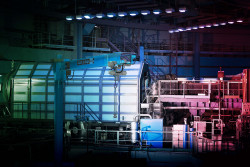Italy celebrates 20 years of scientific excellence through membership of the Institut Laue-Langevin
The ILL was founded 50 years ago in 1967 with the aim creating an intense, continuous source of neutrons devoted exclusively to civil fundamental research. Since then, the ILL has taken on a truly international dimension with the signing of Scientific Membership agreements with a number of European countries, alongside its Associated Members: France, Germany and the United Kingdom. 1997 was a milestone year for Italy, when it became part of this international partnership. About 6% of all scientific visitors at the ILL and 24% of those welcomed from Scientific Member countries are Italian. Some of the most exciting science to be conducted at the ILL recently has come from Italian users. The revelation that ‘quantum tunnelling’ (where a particle ‘tunnels’ through a barrier) on graphene enables the birth of stars in space was discovered by the University of Parma. Work with the same department has brought molecular magnets closer to application in quantum computing – a relatively unexplored field - yet of critical importance for future technologies. Given the European Commission’s planned €1 billion quantum technologies flagship initiative in 2018, ILL is enabling Italian scientists to be at the forefront of European science priorities. In the global context, an ageing population means treating chronic diseases is a scientific challenge. In this area, ILL has supported the University of Milan in contributing to the fight against chronic conditions such as Parkinson’s and Alzheimer’s – mapping the mechanisms underpinning the diseases to contribute to the design of new treatments. Indeed, many more outcomes have been achieved over the years, given the multidisciplinary scope of the transalpine collaboration. Italy was in fact one of the first nations using neutrons for spectroscopy. With no nuclear source of their own since the 1960s, use of the ILL’s world-class facilities and expertise has enabled Italians to maintain influence on the global research stage, impacting areas such as Alzheimer’s, cryopreservation and investigation of life under extreme conditions. The last 18 years of scientific publishing at the ILL is a continued testament to that - publications involving Italian scientists and using data from the ILL account for 8% of the total. As neutrons are non-destructive and can penetrate deep into matter, they are an ideal probe for most materials – including biological samples. Neutrons also possess a magnetic dipole moment, enabling them to reveal precise information on the magnetic behaviour of materials at atomic level. Exploited for these properties, neutrons allow scientists to observe atoms even on a picosecond (one trillionth of a second) time scale, giving them real-time information about where atoms are situated and what laws of dynamics they obey. The provision of neutrons has therefore been critical for Italian users by the ILL – whether academic such as universities or industrial such as Chimet S.p.A. The Arezzo-based company has performed many neutron experiments to help enhance its industrial processes and products, in particular with precious metal catalysts. Another remarkable collaboration began in 2011 with CAEN S.p.A for the development and optimisation of electronics and digital data acquisition systems. “The unique research conducted by Italian users at the ILL over the last 20 years has been essential to solving some of the major challenges facing modern society. Carried out across a broad range of disciplines and feeding into innovation in many different fields of application, including health, materials and the future of computing, I have no doubt that science in Italy will continue to benefit from the unrivalled services provided by the ILL”, says Professor Helmut Schober, Director of the ILL. Read more: http://www.fill2030.eu/2017/10/05/italy-celebrates-20-years-of-scientific-excellence-through-membership-of-the-institut-laue-langevin
Keywords
Neutron, Institut Laue-Langevin
Countries
France



